In a world that is constantly moving and changing, finding ways to connect with your loved ones on a deeper level is more important than ever. One unique and fulfilling way to do so is through practicing yoga poses for two individuals.
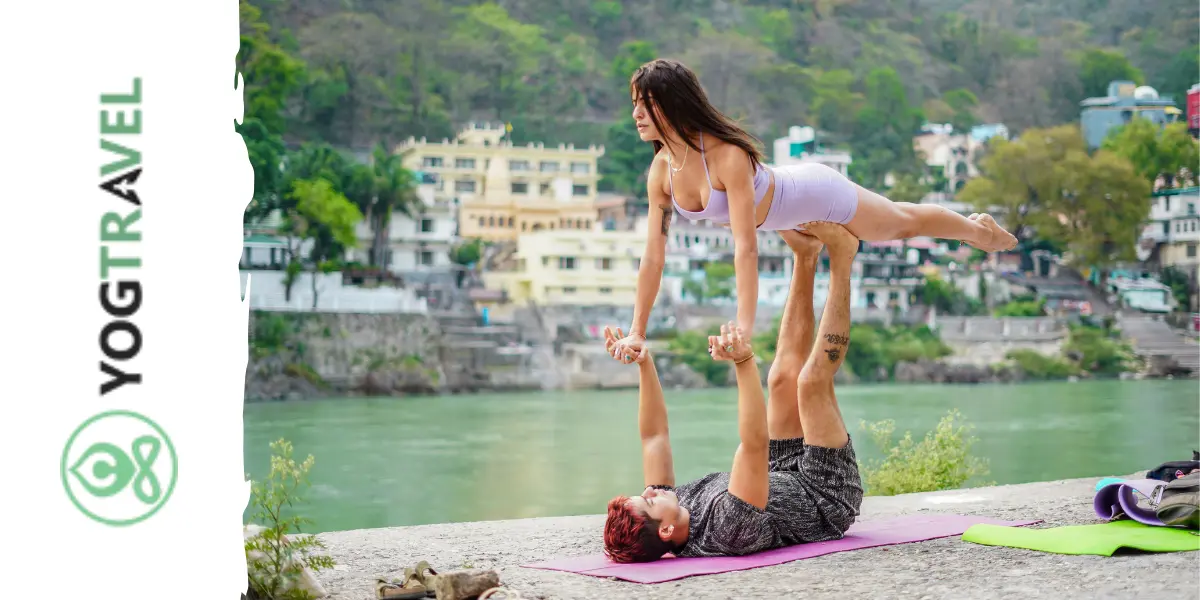
These partner yoga poses not only provide physical benefits but also help strengthen emotional bonds and enhance communication between partners. In this comprehensive guide, we will explore the art of practicing yoga with a partner, its benefits, and some of the most effective poses to deepen your connection.
Understanding Partner Yoga
Partner yoga, also known as AcroYoga, involves two individuals working together to achieve yoga poses that they may not be able to accomplish on their own. This form of yoga emphasizes trust, communication, and synchronicity between partners. It combines traditional yoga postures, acrobatics, and Thai massage techniques to create a unique and engaging experience.
Benefits of Practicing Partner Yoga
Partner yoga offers a range of physical, emotional, and mental benefits. It helps build stronger bonds, enhances flexibility, improves balance, and promotes relaxation. The shared experience of partner yoga fosters a sense of unity and cooperation, which can lead to improved communication and a deeper connection.
Preparing for Partner Yoga
Before embarking on your partner's yoga journey, it's important to establish clear communication with your partner. Discuss your intentions, set goals, and address any concerns. Choose a comfortable and quiet space for your practice and ensure you both are dressed in comfortable attire.
Top Yoga Poses for 2
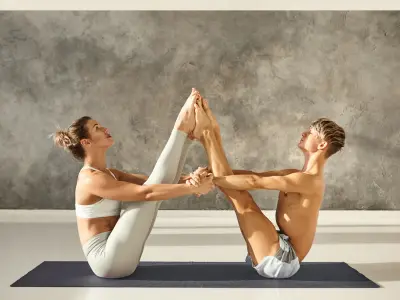
Buddy Boat
Buddy boat yoga poses for two individuals involve engaging in a series of partner-based yoga postures that promote balance, communication, and trust. These poses not only enhance the physical benefits of yoga but also foster a deeper connection between partners.
Remember that partner yoga should be approached with patience and respect for each other's limitations. It's essential to communicate openly about your comfort levels and any concerns to ensure a safe and enjoyable practice. Always listen to your body and your partner's cues during the practice to avoid any strain or discomfort.
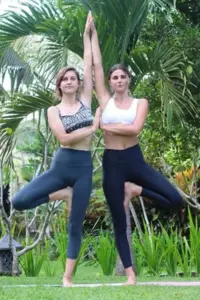
Twin Trees
Twin Tree yoga poses for two bring a delightful blend of balance, communication, and synchronicity to the mat. These poses offer physical benefits and deepen the connection between partners, fostering trust and cooperation. With hands gently resting on each other's shoulders or extended towards the center, balance is key. Finding a common point of focus helps stabilize the posture and enhances the feeling of unity.
Remember, practicing twin tree yoga poses is not just about perfecting the physical form, but also about nurturing the bond between partners.
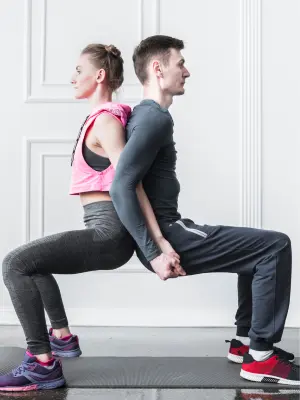
Chair Pose (Utkatasana)
Chair Pose, also known as Utkatasana in Sanskrit, is a standing yoga posture that helps to strengthen the lower body, particularly the thighs, and glutes, while also engaging the core muscles. It's called Chair Pose because when properly executed, it looks like you are sitting on an imaginary chair. This poses challenges to your balance, stability, and strength.
Yoga is not only about the final pose; it's about the journey. Couples that practice Chair Pose together have a terrific time while strengthening their bodies and relationships.
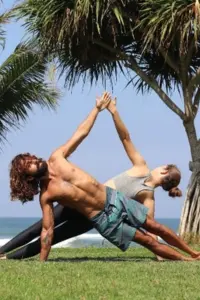
Double-sided plank
The double-sided Plank stands out as a powerful and engaging pose that not only challenges physical strength but also fosters a deep sense of connection and trust between partners. The double-sided Plank, often referred to as the Partner Plank or Tandem Plank, involves two participants facing each other in a plank position, mirroring each other's movements and actions. Both partners support themselves on their hands and toes, forming a straight line from head to heels.
Double-sided plank is more than just a physical posture – it embodies the essence of partnership, unity, and growth. By engaging in this pose together, partners embark on a journey of shared strength, mutual understanding, and interconnectedness
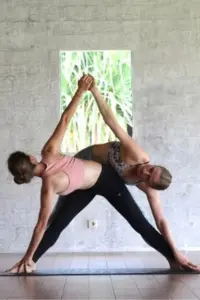
Twisted Triangle
The Twisted Triangle is a captivating yoga pose that beautifully combines balance, flexibility, and strength. This pose, known as "Parivrtta Trikonasana" in Sanskrit, is often practiced for its ability to stretch and energize the body while promoting inner focus and stability.
Practicing the Twisted Triangle pose with a partner not only enhances the stretch and twist but also adds an element of connection and mutual support to the practice. Remember, yoga is about finding a balance between effort and ease, so work within your comfort range and respect your body's limitations.
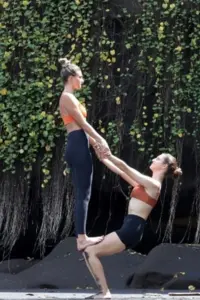
Chair & Mountain pose
The dynamic combination of the "Chair Pose" and the "Mountain Pose" in partner yoga creates a harmonious blend of strength, balance, and support. These poses not only provide physical benefits but also symbolize the essence of unity and partnership.
When practiced together, the Chair and Mountain Poses for partners form a beautiful sequence that embodies both strength and serenity. The Chair Pose encourages participants to lean on each other, showcasing the give-and-take essential in any partnership, while the Mountain Pose symbolizes the unwavering presence and alignment of shared goals. As partners engage in these poses, they create a metaphorical representation of their joint journey – facing challenges with resilience, celebrating victories together, and embodying the essence of unity that underlies a strong partnership.

Assisted Handstand
Assisted handstand yoga poses might be just what you need. These dynamic poses not only enhance your physical strength and flexibility but also cultivate trust and communication between partners. In this article, we'll dive into the world of assisted handstand yoga poses, exploring their benefits, how to perform them correctly, and the unique bond they foster between participants.
Assisted handstand yoga poses offer a thrilling and rewarding experience. Beyond the physical benefits, they nurture trust, communication, and a sense of shared accomplishment. So grab a partner, embark on this journey together, and discover the joy of defying gravity while strengthening your connection.
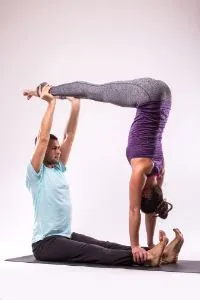
Staff Pose (Dandasana)
Staff Pose, also known as Dandasana, is a seated yoga posture that focuses on alignment and engagement of the entire body. When practicing this pose with a partner, you can both sit facing each other, allowing for mutual support and connection.
Supported Handstand:
Supported Handstand is an inversion that requires strength, balance, and trust between partners. It's a playful pose that allows both participants to explore the sensation of being upside down in a safe and supported manner.
Yoga poses should be practiced with care and respect for your body's limitations. When practicing partner yoga poses, communication and trust between partners are essential to ensure a safe and enjoyable experience. Always listen to your body and modify poses as needed.
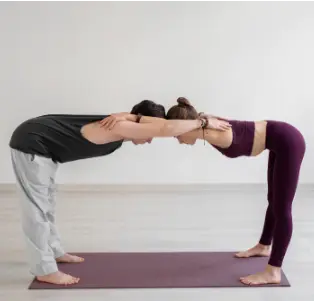
Standing Shoulder Opener
The standing shoulder opener is a dynamic and invigorating yoga pose that brings a sense of openness and connection between two practitioners. This partner yoga pose not only provides a deep stretch for the shoulders, chest, and upper back but also fosters trust and communication between participants.
The standing shoulder opener is not only a physically beneficial pose but also an opportunity to cultivate a deeper connection with your partner. It encourages both partners to synchronize their movements, communicate effectively, and share a unique yoga experience together. This pose can be especially powerful in building trust, as partners rely on each other's support to maintain the pose safely and comfortably.
As with all yoga poses, it's important to practice with mindfulness and respect for your body's limitations. If you're new to this pose or partner yoga in general, it's recommended to practice under the guidance of an experienced yoga instructor to ensure proper alignment and prevent any injuries.

Seated Breathing Pose
The Seated Breathing Pose, often referred to as the Sukhasana or Easy Pose, is a foundational and serene yoga posture that is perfect for practicing in pairs. It embodies the essence of calmness and connection, making it an excellent choice for yoga poses designed for two people.
The Seated Breathing Pose for two serves as a beautiful reminder of the importance of being present and connected with others. It offers an opportunity to cultivate a sense of unity, harmony, and shared mindfulness. This pose encourages deep breathing, relaxation, and an increased awareness of your own body, as well as the energy you share with your partner.
Communication and Trust Building
Partner yoga relies heavily on communication and trust. Learning to express your needs, listen actively, and provide feedback fosters a deeper understanding of each other's feelings and limitations.
Physical and Mental Synchronization
The practice of synchronized movements in partner yoga creates harmony between partners. It encourages you to be present in the moment and enhances your ability to empathize with your partner's experience.
The Power of Touch and Support
Physical touch releases oxytocin, the "bonding hormone," which helps strengthen emotional connections. Partner yoga provides ample opportunities for touch, promoting a sense of security and emotional intimacy.
Overcoming Challenges Together
Partner yoga presents challenges that require joint problem-solving. Facing and overcoming these challenges together can lead to a greater sense of accomplishment and shared joy.
Breathing in Harmony
Synchronized breathing fosters a sense of unity. In partner yoga, breathing together creates a rhythm that promotes relaxation and shared focus.
Mindful Meditation for Two
Practicing meditation with your partner enhances your ability to be present together. It deepens your connection by allowing you to explore your inner experiences as a team.
Strengthening Intimacy Through Yoga
Partner yoga invites vulnerability and openness. By working together in poses that require support and balance, you create a safe space for vulnerability and emotional connection.
Sharing Positive Energy
Partner yoga exchanges positive energy and intentions. This shared positivity can lead to a more optimistic outlook on your relationship.
Building Playfulness and Laughter
The joy of practicing partner yoga often leads to laughter and playfulness. Infusing these lighthearted moments into your practice can strengthen your bond.
Practicing Gratitude as a Pair
Closing your partner's yoga sessions with a gratitude practice reinforces your appreciation for each other. It cultivates a sense of thankfulness and acknowledges the effort you both put into the practice.

Conclusion
Partner yoga offers a unique pathway to deepening bonds between individuals. By embracing the physical, emotional, and mental aspects of this practice, you and your partner can unlock a new level of connection. Through synchronized movements, shared breath, and the power of touch, partner yoga provides a platform for enhanced communication, trust, and intimacy.
FAQs
-
Is partner yoga suitable for all fitness levels?
Partner yoga can be modified to accommodate various fitness levels. Start with poses that match your capabilities and gradually progress.
-
Do I have to have earlier yoga experience to rehearse accomplice yoga?
While prior yoga experience can be beneficial, it's not mandatory. Accomplice yoga stances can be adjusted to suit amateurs.
-
Can partner yoga be practiced with friends or family members?
Absolutely! Partner yoga is not limited to romantic partners. It can be enjoyed with friends, family members, or even colleagues.
-
Are there any safety considerations for partner yoga?
Safety is paramount. Always communicate openly with your partner, and don't push yourself into poses that feel uncomfortable or risky.
-
How often should we practice partner yoga?
The frequency depends on your schedules and preferences. Consistency is key, so aim for regular practice without overexerting yourselves.
